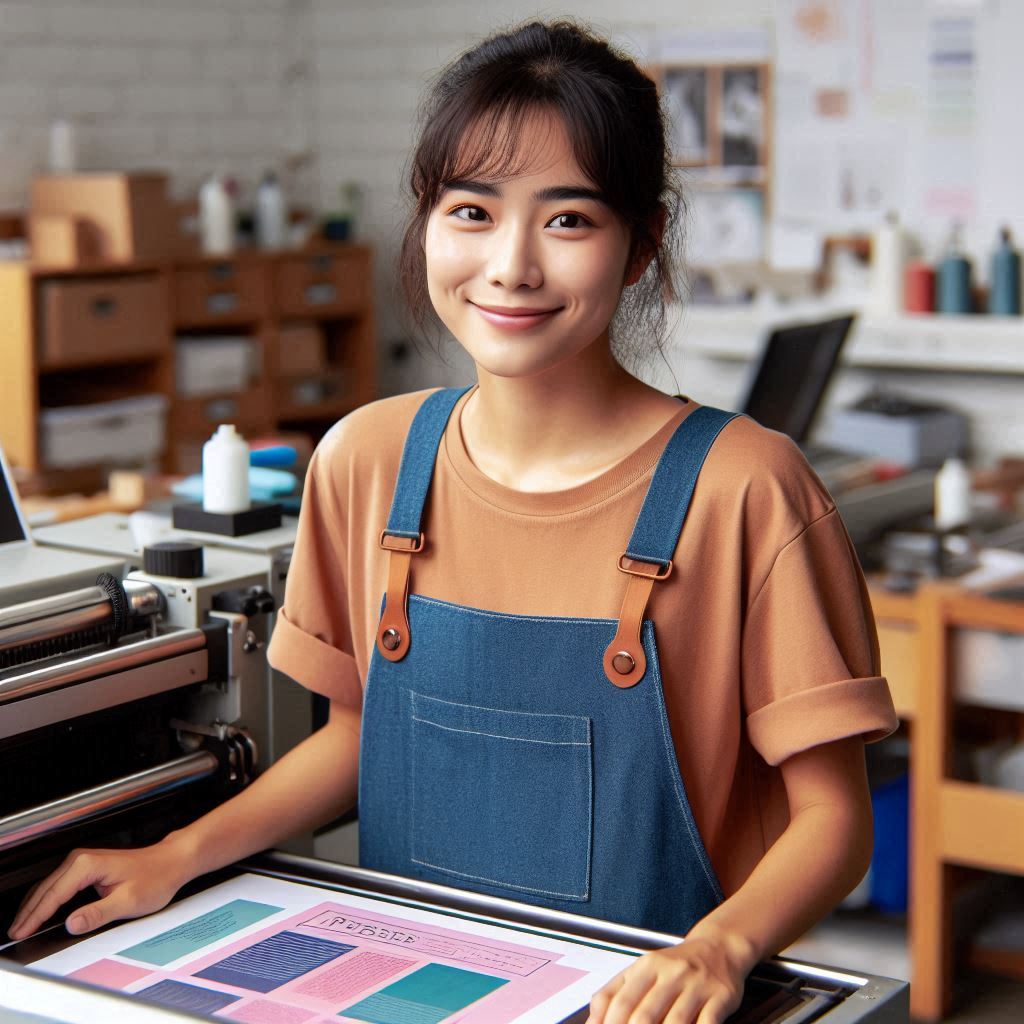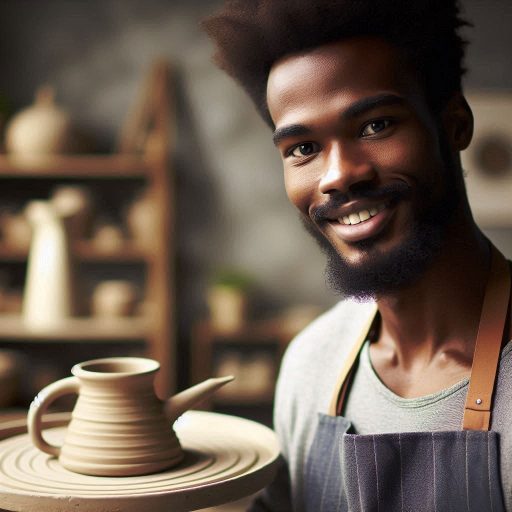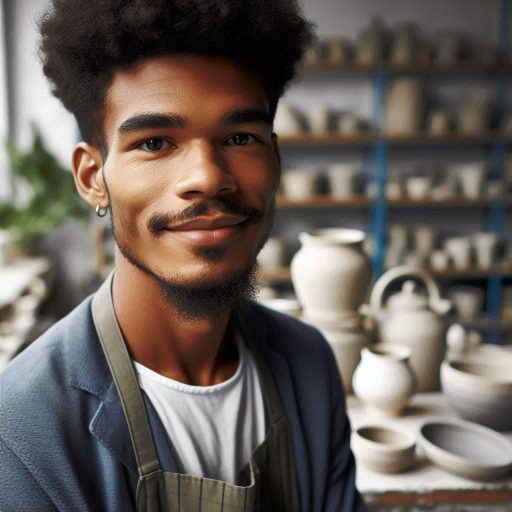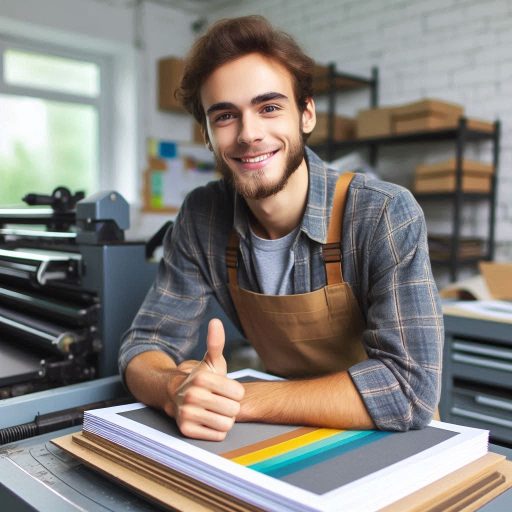Introduction
Printmaking is a dynamic art form with various techniques, each offering unique creative possibilities.
Artists use printmaking to replicate images, explore textures, and experiment with colors.
Among these techniques, monotype printing stands out for its distinctiveness and spontaneity.
Monotype printing involves creating a single, unique print from a painted or inked plate.
Unlike other printmaking methods, it yields only one print from each prepared surface.
The process begins with applying ink or paint onto a plate, which can be a metal, glass, or acrylic surface.
Artists then manipulate the ink using tools or their hands. Finally, they press the plate onto paper to transfer the image.
The importance of monotype printing in the art world lies in its versatility and immediacy.
It allows artists to create spontaneous, one-of-a-kind works.
This technique breaks free from the traditional repetition of printmaking, offering a fresh approach to artistic expression.
Monotypes often feature unique textures and vibrant colors that are difficult to achieve with other methods.
This unpredictability and freedom are highly valued in contemporary art, making monotype printing a favored choice for artists seeking to explore new creative territories.
In summary, monotype printing provides a special avenue for artistic exploration.
Its ability to produce unique prints and embrace creativity makes it a significant technique in printmaking.
Whether for its innovative qualities or its role in enhancing artistic practice, monotype printing holds a vital place in the art world.
History of Monotype Printing
Origins of Monotype Printing
Monotype printing originated in the early 17th century, with its roots tracing back to experimental artists.
The technique emerged as an innovative method for creating unique prints.
Unlike traditional methods, monotype printing involves creating a single print from a painted or inked plate.
This process offers a spontaneous, one-of-a-kind result.
Initially, artists used this technique to explore new artistic expressions.
Transform Your Career Today
Unlock a personalized career strategy that drives real results. Get tailored advice and a roadmap designed just for you.
Start NowThe origins of monotype printing reflect a period of experimentation and creativity.
Development and Evolution of Monotype Printing Techniques
As the technique evolved, artists refined the process and developed new methods.
In the 18th century, the technique saw advancements with the introduction of new materials and tools.
The development included the use of various inks and paint mediums, enhancing the print’s texture and quality.
By the 19th century, artists began incorporating monotype printing into their broader artistic practices.
Innovations such as the use of different types of paper and pressure methods further advanced the technique.
This evolution marked monotype printing as a significant method in modern art.
Famous Artists Known for Using Monotype Printing in Their Work
Several renowned artists have significantly contributed to the popularity of monotype printing.
Edgar Degas, a prominent figure, experimented with this technique extensively, producing vibrant and dynamic prints.
Henri Matisse also utilized monotype printing, integrating it into his diverse body of work.
In the 20th century, artists like Pablo Picasso embraced the method to create unique and expressive pieces.
Their use of monotype printing helped establish its place in the art world, showcasing its versatility and impact.
Read: The History and Evolution of Ceramic Art
Materials and Tools Needed for Monotype Printing
When embarking on a monotype printing project, it is essential to gather all the necessary materials and tools to ensure a successful and enjoyable printing experience.
By having the right supplies on hand, artists can fully explore the creative possibilities of this versatile printmaking technique.
Paper types for monotype printing
One of the critical components of monotype printing is selecting the appropriate paper that will absorb the ink correctly and allow for smooth transfer onto the final print.
There are various paper types available, each with its unique properties that can enhance the overall look of the print.
When choosing paper for monotype printing, consider factors such as weight, texture, and absorbency.
Lightweight papers like rice paper or newsprint are ideal for beginners as they are easy to work with and facilitate the transfer of ink from the plate to the paper.
Showcase Your Business Today
Reach thousands of readers actively exploring professional services. Publish your business profile and grow your audience now.
Publish NowThese papers are also cost-effective, making them suitable for practicing and experimenting with different techniques.
For artists looking to create more robust and textured prints, heavyweight papers like watercolor paper are an excellent choice.
These papers can withstand the pressure and moisture involved in the printing process, resulting in more durable and long-lasting prints.
Additionally, the texture of heavyweight papers can add depth and dimension to the final artwork, creating a visually appealing finished piece.
Smooth papers are ideal for capturing fine details and intricate designs, making them suitable for artists who prefer a more precise and controlled printing process.
On the other hand, textured papers can add an organic and tactile quality to the prints, giving them a unique and handcrafted feel.
Experimenting with different paper types can help artists achieve various effects and styles in their monotype prints, making the creative process more dynamic and exciting.
Inks and paints suitable for monotype printing
Inks and paints play a crucial role in monotype printing, as they are used to create the image on the printing plate and transfer it onto the paper.
Selecting the right ink or paint can significantly impact the final outcome of the print, so it’s essential to choose materials that suit your desired aesthetic and printing style.
Oil-based printing inks are commonly used in traditional monotype printing due to their rich and vibrant colors, slow drying time, and smooth texture.
These inks are easy to work with and allow artists to create detailed and layered prints with excellent clarity and depth.
However, oil-based inks require proper ventilation and cleanup with solvents, making them less convenient for artists seeking a cleaner and more environmentally friendly option.
Water-based inks are an excellent alternative for artists looking to reduce their environmental footprint without compromising on quality.
These inks are non-toxic, water-soluble, and easy to clean up, making them suitable for artists working in shared studio spaces or at home.
Water-based inks also offer a fast drying time, allowing artists to work quickly and experiment with different layers and colors in their prints.
Acrylic paints are another versatile option for monotype printing, providing artists with a wide range of colors and textures to work with.
Acrylic paints dry quickly and can be easily mixed to create custom colors, making them ideal for artists who enjoy experimenting with different techniques and effects.
While acrylic paints can be used on their own for monotype printing, they can also be combined with other mediums like ink or watercolor to create unique and dynamic prints.
Brayers, brushes, and other necessary tools for the process
In addition to paper and ink, artists will need various tools to facilitate the monotype printing process and achieve their desired results.
Brayers, brushes, and palette knives are essential tools that can help artists create intricate details, blend colors, and add texture to their prints.
A brayer is a specialized roller used to apply ink evenly on the printing plate, ensuring smooth and consistent coverage for the final print.
Brayers come in different sizes and materials, with soft rubber rollers being ideal for monotype printing as they can easily pick up and transfer ink without leaving streaks or marks on the plate.
Artists can also use brayers to blend colors, create gradients, or add texture to their prints, making them a versatile tool for experimentation and creative expression.
Brushes are another essential tool for monotype printing, allowing artists to add fine details, intricate patterns, or additional colors to their prints.
Different brush sizes and shapes can create unique effects on the plate, ranging from bold strokes to delicate lines.
Artists can experiment with various brush techniques, such as stippling, cross-hatching, or dry brushing, to add depth and dimension to their prints and enhance the overall composition.
Palette knives are useful for mixing and applying ink or paint on the printing plate, allowing artists to create custom colors and textures for their prints.
Read: Exploring Abstract Printmaking Techniques

Techniques of Monotype Printing
Monotype printing, a unique printmaking technique, offers a range of creative possibilities.
Let’s explore its techniques, including the direct and indirect methods and variations to achieve different effects.
Direct Method of Creating Monotypes
The direct method involves applying ink or paint directly onto a plate or surface.
Artists use brushes, rollers, or their hands to create their design.
After applying the medium, they place a sheet of paper over the surface and apply pressure, transferring the image.
This method allows for spontaneous and intuitive designs, as the artist can manipulate the ink directly.
It’s ideal for creating bold, expressive prints with rich textures and colors.
Indirect Method of Creating Monotypes
In the indirect method, artists first create their design on a separate sheet or surface using a medium like oil-based ink.
Once the design is complete, they transfer it onto the final paper using a press or by hand.
This technique allows for more detailed and controlled prints, as artists can work on their design before making the final transfer.
The indirect method is suitable for intricate patterns and precise details, providing a different set of artistic possibilities compared to the direct approach.
Variation in Techniques for Achieving Different Effects
Monotype printing techniques can be varied to achieve diverse effects.
Showcase Your Business Today
Reach thousands of readers actively exploring professional services. Publish your business profile and grow your audience now.
Publish NowBy adjusting the amount of ink or paint and experimenting with different tools, artists can create various textures and patterns.
For instance, using a brayer can produce smooth, even layers, while a palette knife can create rough, textured effects.
Additionally, incorporating multiple layers or combining monotype with other printmaking techniques can result in unique and complex prints.
Experimentation with these techniques allows artists to push the boundaries of traditional monotype printing and discover new creative avenues.
By mastering both the direct and indirect methods and exploring variations, artists can fully utilize the expressive potential of monotype printing.
Read: Common Mistakes to Avoid in Printmaking
Step-by-Step Guide to Monotype Printing
Preparation of Work Surface
Start by choosing a clean, flat surface for your printmaking.
Cover it with a protective layer like plastic or newspaper.
Ensure your work area is well-ventilated.
Gather your tools: a glass or acrylic sheet, brayer (roller), and a palette.
Arrange your inks or paints, brushes, and paper. Keep water or solvent handy for cleanup.
Having everything in place ensures a smooth printing process.
Applying Ink or Paint
Begin by squeezing a small amount of ink or paint onto your glass or acrylic sheet.
Use a brayer to evenly roll out the ink, creating a thin, smooth layer.
You can mix colors on the sheet for custom shades.
For texture, try using different tools like brushes or palette knives.
Apply the ink or paint directly onto the sheet, keeping your design in mind.
Avoid overloading the brayer to prevent excess ink from affecting your print.
Creating the Print
Place your chosen paper gently on top of the inked sheet.
Apply even pressure by hand or using a press if available.
Smooth out the paper to ensure good contact with the ink.
Carefully lift the paper from one edge to avoid smudging.
If using multiple colors, allow each layer to dry before applying the next.
Experiment with different techniques for varied effects, like textures or overlays.
Finishing Touches and Clean-Up
Once your print is dry, assess it for any desired touch-ups.
Add details or refine areas with additional ink or paint if needed.
Allow the print to fully dry before handling.
Clean your work surface and tools immediately to prevent ink from drying and becoming difficult to remove.
Dispose of any waste materials properly.
Store your prints flat and protected to avoid damage.
Enjoy the unique results of your monotype printing!
Read: The Role of Technology in Ceramic Art
Examples of Monotype Prints
Monotype printing is a versatile and unique printmaking technique that allows for endless possibilities in creating one-of-a-kind artwork.
Here are some examples of monotype prints that showcase the beauty and variety of this technique:
Showcase of Different Monotype Prints
Each of these examples demonstrates the endless possibilities of monotype printing, from realistic representations to abstract interpretations.
The technique involves creating an image on a smooth surface, like glass or acrylic, and transferring it onto paper through pressure, resulting in a unique, one-off print.
How Techniques Were Used to Achieve Specific Effects
Monotype printing offers artists the opportunity to experiment with various techniques to achieve specific effects in their prints.
For example, using different types of paper can affect the texture and finish of the print, while varying the amount of ink or pressure applied can create light and shadow in the image.
Additionally, artists can use tools like brushes, rollers, or stencils to add layers and details to their monotype prints, resulting in complex and visually interesting artworks.
By combining different techniques, artists can create prints that are rich in depth and texture, evoking a range of emotions and responses from viewers.
Showcase Your Business Today
Reach thousands of readers actively exploring professional services. Publish your business profile and grow your audience now.
Publish NowInspiration for Artists Interested in Trying Monotype Printing
If you’re an artist looking to explore new printmaking techniques, monotype printing offers a creative and rewarding experience.
The spontaneity and unpredictability of the process can lead to surprising and delightful results, making each print a unique work of art.
Experiment with different materials, tools, and techniques to discover your own style and voice in monotype printing.
Whether you’re drawn to the bold colors and textures of abstract prints or the delicate details of still life compositions, there’s endless potential for exploration and growth in this versatile technique.
Take inspiration from the examples mentioned above and start experimenting with monotype printing to see where your creativity takes you.
Dive into this expressive and dynamic printmaking technique and uncover the endless possibilities it offers for creating beautiful and engaging artwork.
Benefits of Monotype Printing
Unique Qualities of Monotype Prints
Monotype printing stands out for its distinct, one-of-a-kind results.
Each print is unique due to the unpredictable nature of the process.
Unlike other printmaking techniques, no two monotypes are identical.
This uniqueness comes from applying ink or paint to a plate and then transferring it to paper.
The resulting print captures the artist’s immediate expressions and marks.
The final piece often exhibits rich textures and subtle variations, making each print a singular artwork.
Spontaneous and Experimental Nature of the Process
Monotype printing encourages spontaneity and experimentation.
Artists can freely explore their ideas without rigid constraints.
The process involves applying ink to a plate and manipulating it before making a print.
This allows for immediate adjustments and creative decisions.
The absence of multiple editions means artists can experiment with different techniques and materials.
Each print becomes a fresh exploration of possibilities, embracing mistakes and surprises along the way.
Opportunities for Creativity and Exploration in Art Making
The monotype process offers extensive opportunities for artistic creativity.
Artists can use various tools and methods to manipulate the ink on the plate.
This includes brushes, rollers, and even unconventional objects.
The technique also supports layering and texture, adding depth to the artwork.
Artists are free to combine monotype with other media, such as painting or drawing, to enhance their creative expression.
This flexibility fosters a playful and innovative approach to art-making.
Monotype printing, with its unique qualities, experimental nature, and creative potential, offers a compelling avenue for artists.
Each print captures a moment of artistic discovery, making it a valuable technique for those seeking originality in their work.
Conclusion
Monotype printing offers artists a unique and versatile technique for creating one-of-a-kind prints.
The spontaneity and unpredictability of the process result in prints that are rich in texture and depth .
Monotype printing allows artists to experiment with different materials and tools to achieve various effects.
This form of printmaking encourages creativity and exploration, making it an exciting and rewarding art form to explore.
Monotype printing is a significant printmaking technique that allows artists to create original, expressive prints with a painterly quality.
It offers a sense of freedom and spontaneity that is not typically found in other forms of printmaking.
If you are looking to expand your artistic horizons, consider exploring monotype printing.
The process is accessible to artists of all skill levels and offers endless possibilities for experimentation and creative expression.
To delve deeper into monotype printing, check out workshops, classes, and online tutorials.
Visit art supply stores for materials like printing inks, brayers, and printing plates.
Join printmaking communities to connect with other artists and share tips and techniques.
[E-Books for Sale]
The Big Book of 500 High-Paying Jobs in America: Unlock Your Earning Potential
$19.99 • 500 High-Paying Jobs • 330 pages
Explore 500 high-paying jobs in America and learn how to boost your career, earn more, and achieve success!
See All 500 High-Paying Jobs of this E-Book
1001 Professions Without a Degree: High-Paying American Jobs You Can Start Now
$19.99 • 1001 Professions Without a Degree • 174 pages
Discover 1001 high-paying jobs without a degree! Unlock career tips, skills, and success strategies for just $19.99!




